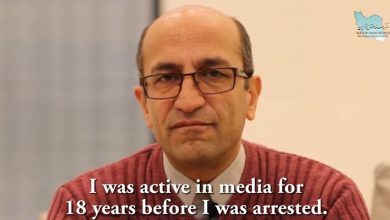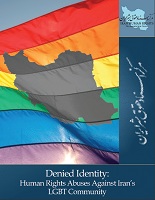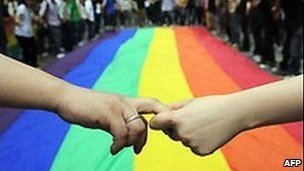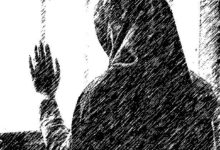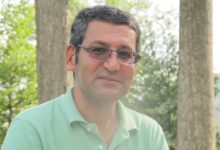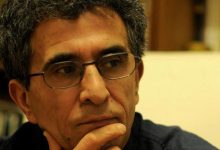Witness Statement of Hamed, an Iranian homosexual
He also reveals how he helped establish and celebrate the first National Day of Sexual Minorities in Iran in Tehran in 2010.
Name: Hamed (Pseudonym)
Place of Birth: Tehran, Iran
Date of Birth: 1982
Occupation: Computer Programmer
Interviewing Organization: Iran Human Rights Documentation Center (IHRDC)
Date of Interview: 16 October 2012
Interviewer: IHRDC Staff
This statement was prepared pursuant to an interview with Hamed (Pseudonym). It was approved by Hamed on February 25, 2013. There are 43 paragraphs in the statement.
The views and opinions of the witness expressed herein do not necessarily reflect those of the Iran Human Rights Documentation Center.
Background
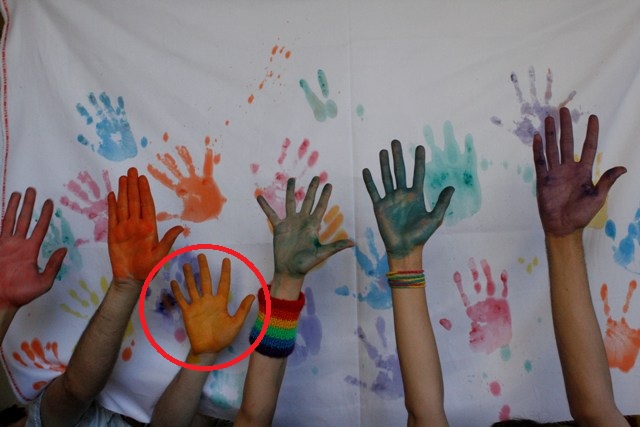 |
| The first celebration of the National Day of Sexual Minorities in Iran (Tehran 2010) *The hand circled in red is Hamed’s. |
1. My name is Hamed and I was born in Tehran in 1982. I am homosexual. I worked as a computer programmer in Tehran. I have a diploma in mathematics and physics. I was studying computer hardware in the university but I was expelled for academic reasons. That is, I was under extreme psychological pressure from my family which prevented me from continuing my studies. Our family included my father, my mother and younger brother. Both my parents have masters’ degrees and are not very religious.
2. For as long as I can remember I was different from others. I was different than my brother, for instance. He liked playing football but I liked playing with dolls. When I was a child I sometimes tried on girls’ clothes. Sexually it did not mean much to me at the time. But as I got older I would compare myself with my classmates and I noticed that my interests and tastes were different than theirs.
3. It was in high school when I noticed I was sexually attracted to my own gender, not the opposite sex, and my classmates had a different inclination. A distance was building between my classmates and I in terms of life style and manners and it made me notice that I was different.
4. My family always thought I was homosexual because they could see that my mannerisms were not very “boyish”. So they were always worried about me. When I found gay friends and began to spend time with them, my family began to criticize me and they controlled my phone calls. Meanwhile we had a series of arguments within the family and I told them openly that I am homosexual. They reacted badly. They fought with me and yelled at me to change my behavior.
5. It came to a point where in 2001 [when I was 19] I was taken to a psychiatrist. One of the big problems at the time was that no one—not the LGBT [lesbian, gay, bisexual, transsexual] minority ourselves or even psychiatrists and psychologists—had much information about this issue. The psychiatrist gave me a physical examination and then asked me a series of questions like, “Do you have problems with your father or mother?”, “Do you have relationships with the opposite sex?” I said “no”. “How about with your own gender?” And I said “yes”.
6. His questions boiled down to a single issue—he constantly asked if I had ever watched my parents having sex. I said I had not. He repeated the question. He recommended that I write the sentence: “I am a good boy” a 100 or 200 times on a piece of paper. And things like this. After the first visit I didn’t go back and I didn’t write those sentences because I thought they weren’t useful and wouldn’t solve anything. This was a really bad experience for me because the psychiatrist did not know anything.
7. Later on in 2003 I went to see a psychiatrist who was a psychologist recommended by my mother. I was much more serious this time and I explicitly told him that I am homosexual and want to live the way I am and I want to solve the problems I have with my family. I went to a few sessions and my mother spoke to him as well. The doctor recommended that I should try to have relationships with the opposite sex. He asked my parents to take steps in this direction [of initiating relationships with females] but they did not show any flexibility and I did not do anything either. So as a result my second attempt at seeing a doctor also ended in failure.
8. I think the biggest problem I had in all these years was that there was a systematic effort by the government, the authorities, schools and media to label people like myself as sinners. They believed we are bad and said things like AIDS was caused by homosexuals. Or that we are deviant and so on and so forth. I suffered a lot under this pressure at a time when I was trying to know myself. I was uncertain and did not have a lot of information. And this bombardment of propaganda against homosexuals in Iran really bothered me during my youth.
9. Another issue was the legal aspect. The punishment I could have faced was execution or stoning. That was extremely terrifying for me. On the one hand there was the systematic aspect imposed by the government and on the other hand, families, kids my age, my classmates and society put pressure on me as well.
10. There are a series of systematic actions being carried out by the government against homosexuals. One form of action is negative propaganda and the other, which is very serious, is what is happening in universities regarding the way they teach humanities. Those who major in humanities and become psychologists and psychiatrists should have information about homosexuality but they don’t. The information they have about sexual matters is very little.
11. I know a lot of students who wanted to organize question and answer meetings for the LGBT community at the university but they were prevented for various reasons. These sorts of roadblocks in scientific settings are part of systematic actions by the government. They have a deep impact because when a young person goes to a psychologist with a problem, the information that is given is dictated by the government and, from what I have personally observed, this can sometimes lead to suicide. Even if they do not kill themselves, it kills their spirit.
12. I have always thought that if I want to have a personal life, I need to make some changes in my surroundings and create a network of people who think like myself so that we can support each other. On the internet I discovered one of the first Iranian gay sites called “GayIran”. Through that site I was able to find friends who had similar interests and some who were social activists. I learned a lot from their experiences and gradually I joined LGBT society.
First LGBT gathering in Tehran
13. In October 2000, a group of LGBT activists decided to have a gathering. They wanted to invite people to meet at a certain time in Mellat Park in Tehran. They wanted to have this meeting to get rid of their fears [of gathering in public]. [The idea was that] individuals would see each other and realize they are not alone and they can be in a group. I liked the idea and invited my friends. I organized the route and set the meeting time. This was my first formal experience as an activist. I did everything I could. It was a small step which helped us find others who were interested in social work.
14. On the day of the gathering we planned to meet in groups of four around the pond in Mellat Park. Many people showed up and the area filled with people. We met new people and for some of them it was important to take certain steps. It was important for us to meet up close and break the ice so that we could do other things in the future.
15. The Park Mellat gathering was a one-time event but it was a very good idea. Later we came up with better ideas. For instance the following year there were weekly meetings in Mellat Park in certain places and at certain times. These meetings were no longer just for the purpose of meeting and walking with each other. For example 20 or 30 of us would form a circle and talk about different subjects, such as our relationship with our family, or legal matters, execution of homosexuals, and how to resolve issues at the work place. Each time we discussed a specific topic. Later on we were able to have focused and more organized groups. These meetings continued until recently.
Iranian LGBT Society: Activities and Challenges
16. I tried to establish contact with those who were socially active before my time. There were magazines, such as Hooman[1], which at the time were published outside Iran. We read and shared them, or translated them into Persian and passed them to others.
17. Later on I began my internet activities, bit by bit. At the time blogs were not the same as they are today but we created pages similar to blogs where we could write opinions and people could leave comments. This allowed discussions to take shape and as a result the LGBT community became more mature. We were able to pass along original information and polish our views.
18. As a result of these discussions the guilty feelings and the negative self-image injected into us lessened to a certain degree. [The discussions] became the basis for the later publication of magazines such as Cheragh[2] and Maha[3]. In addition, homosexual bloggers were able to come forward and write better pieces. I also wrote articles, did translations and participated in discussions.
19. One of the major problems we had is that homosexuals would see psychiatrists and psychologists but instead of receiving help they returned more damaged. Seriously damaged. They were given drugs and hormone treatments that had no benefits and in fact caused a lot of damage.
20. For this reason I began to have conversations with a number of prominent psychologists, including Mr. Mohsen Mansouri-Far, who had a television program at the time.[4] They were the ones LGBT individuals often had consultations with. I wanted these psychologists to study the research on LGBTs and make them understand that homosexuals were not coming to see them in order to change themselves but rather to discuss their problems. I told them: you think you have treated someone with your advice and sent him home. But I see that the individual who has come to see you has not been treated and is suffering.
21. I do not know how effective these meetings were but in any case they did generate discussions. At the time Dr. Mehrabi was a specialist on sexuality in Iran and he helped a lot in starting a new wave among academics and psychologists to at least make them more aware of current knowledge.
22. Later on there were a series of meetings with a psychologist whose name I have forgotten unfortunately. He was the publisher of a magazine called “Iranian Psychology”, or something similar, which was eventually banned. He organized meetings in his office where LGBTs participated and discussed issues freely. It was a good opportunity because he was a professor and his students would come to the meetings and listen to what we had to say. These meetings created the foundation for a discussion between us and the academic community in Iran.
23. Later on, the Iranian Health Organization, which had a budget to help transsexuals (unrelated to homosexuals), held meetings to discuss those who were experiencing a sexual identity crisis. We took advantage of these meetings and many of the participants were homosexuals, not transsexuals. The meetings took place in a formal setting inside a government building and therefore we felt secure. There were psychologists and psychology students as well and we felt this was an opportunity for us to comfortably discuss our issues with the academic community and open up some topics for discussion. As such the Health Organization provided an indirect service to homosexuals under the pretext of discussing sexual ambiguity. This was the only way we were able to make contact with the government. After a while these meetings stopped.
24. Later on I expanded my activities. I published newsletters with a home printer and distributed them to friends who did not have internet. I launched several web sites, which I still have, and continued my work in this fashion.
National Day of Sexual Minorities in Iran
25. The last major project we organized was the National Day of Sexual Minorities in Iran in 2010 which was widely covered by the media and got a lot of attention.
26. We did not have a very organized or centralized group. We did not have official meetings and we did not issue statements. We were about 10 to 15 individuals who gathered and made decisions. Eventually it was proposed that we mark the national day on the first Friday of the month of Mordad [July 2010]. Initially some opposed this date.
27. But in any case on that day we gathered at the home of our friend and made rainbow-colored flags and balloons. We took many pictures—without showing our faces, of course—which were published by the media. We also wrote a series of articles and explained our position. We did everything we could to turn it into a significant event.
28. Inside Iran, Resalat newspaper published the news which was then quoted by online publications. The article included something irrelevant about a group of feminists meeting in Europe which had nothing to do with our gathering. It said a group of Iranian LGBTs had designated the 1st of Mordad [July 23] as the national day of homosexuals in Iran. In any case the publication of this article in Resalat was free advertising for us in a national newspaper. Other domestic newspapers such as Baztab and Tabnak and others copied the news from Resalat and published it as well. The media outside Iran, including Radio Koocheh and Radio Zamaneh, also published the news about our gathering.
29. There is still a difference of opinion within the LGBT community about whether the national day should be observed on the first Friday of the month of Mordad or on the first of Mordad (July 23). But in any case in 2010 the first of Mordad fell on a Friday.
30. The wide coverage of the national day and my role in it put me in a more dangerous situation. A number of homosexuals and other LGBT minorities objected and accused us of making an arbitrary decision. In the ensuing arguments some of the information about us and our identities became public. Willingly or unwillingly, some of the people who knew us gave out information which revealed our identities.
31. I had tried to isolate and separate my activities. For instance if I took part in the meetings at the Health Organization, I did not mention it in my blog and I did not reveal my background to the health officials. Everything I did was on a separate track but all of a sudden there was information on the internet which linked all my activities. And this created a security problem for me.
32. For a while I stopped my activities and turned off my phone and did not go online. I was hoping all the noise would die down. But as time went by there was more and more information coming out on the internet.
Leaving Iran
33. In May 2012 I was in a bad situation because my identity had been exposed. I was the editor of several web sites spreading information about homosexuals. I used secure software and logged in through proxy web sites to avoid being identified. But in the course of several days I noticed I was having problems and I could not open my web site. At first I did not take it seriously. I used special software and monitored all my online communications. Then I noticed that even though I was using a secure proxy to connect to my site, the IP address was in Iran. At a minimum, the Iranian government was able to track who was logging in and gaining access as the administrator of my web site. They could easily know that the site belonged to me. It took me four or five days to confirm that my identity on the internet had been blown. After that I legally crossed the border into Turkey in May 2012.
Diversity of Sexual Minorities
34. There are many kinds of sexual minorities. Bisexuals, for instance, consider themselves a sexual minority even though in a society-wide survey they may prove to be in the majority. It is the discrimination against them which makes them a minority. They are in a special situation. Historically, bisexuality was prevalent in Iran. It was common for men to have sex with young boys at Caravanserais[5], even though they were married and had children. To some extent it can be said that bisexuality in Iran was mainstream and I think it is still the same in some sectors of our society. But this tendency is very different from trans-sexuality or homosexuality.
35. The outlook of some transsexuals towards marriage and family is perhaps the same as heterosexuals. A male transsexual who wants to be a woman truly believes he is a woman and wants to marry a man or to have a boyfriend. They think like heterosexuals. If they have not had a sex change and wear make-up and change their appearance, they will face a lot of problems in society. We [Iranian society] have certain standards in our society and if you do not look like a man or dress in a particular way it will cause problems.
36. The problem facing homosexuals is different. We may not dress like transsexuals or have the same appearance as heterosexuals, but our life style is very different than what Iranian society or a normal family expects of us. You may not see a homosexual in reverse gender roles but our lifestyle or tastes and social outlook may be different from a heterosexual.
37. There are no statistics on the number of sexual minorities in Iran. However various government organizations have done surveys on transsexuals who have undergone sex change operations. But these numbers are not accurate either. And there are no numbers at all on the homosexual population.
Reconciling LGBTs with Iranian Society
38. To convince a person not to oppose LGBTs, we need to determine what motivates a person to oppose LGBTs? Iranian diplomats have political motives. They have no religious, social or scientific convictions. To make them accept LGBT rights, [we should] promise them benefits or put them under political pressure. That’s how you can convince Iranian diplomats.
39. The issue religious people have with us is that from their point of view the Shi’ite religion in Iran has a fixed foundation and if they show flexibility on issues like the hijab, or women or homosexuals it would be a big retreat from their principles. Strategically, it would be unacceptable to them. The only way to change religious views is that first there needs to be some social grounds for an ayatollah to issue a favorable fatwa and then society can support it. You can have discussions with an ayatollah and explain the situation. Then perhaps religious people can change their views. But if there is no social context to accept us, no amount of religious explanation can have any impact.
40. There are also some people who may not have a religious role in society but have religious convictions. These people are very rare. They have no bad intentions. They see religion only as a means to have a connection with God. They never bother me because of my homosexuality. Those who are truly religious and do not mix religion with politics give us the least problems.
41. There is also a certain group of people who oppose us because of their misguided convictions and society’s bad views of us. For instance there are families that may not be religious and may even have a bit of a scientific outlook, but still oppose us because they want to protect their reputation. Or they may fear how the government or society would react. As far as my experience is concerned, there is no use in talking to these kinds of family members. If their son says he is gay, the only thing they will worry about is, can he find a job or not? Would he be expelled from the university? Would relatives stop seeing us?
42. If social conditions change and people’s social views improve, then there will be a gradual change in attitudes as well. But as long as things remain the same, no amount of logic and reasoning can make a difference. That’s how it was with my family. What they worried about is how my aunt and uncle would react towards me if [they knew my orientation] and we went over their house tomorrow?
43. One thing that really helps in changing the general public’s views is when homosexuals come out of hiding. When a homosexual sits in front of the camera and people can see his face on television, it makes a very big difference. When I tell people at work that I am gay and they look at me and they see there’s no problem, this changes their outlook. This is the most effective thing we can do because theoretical discussions have limited impact.
[1] Hooman magazine was established and run since December 1990 by the “Hooman group”, a group that included some Iranian LGBTs based in Sweden. See: http://www.hamjensgera.com/wiki/%D9%85%D8%AC%D9%84%D9%87_%D9%87%D9%88%D9%85%D8%A7%D9%86
http://www.hamjensgera.com/wiki/%DA%AF%D8%B1%D9%88%D9%87_%D9%87%D9%88%D9%85%D8%A7%D9%86
[2] Cheragh magazine is run by the Iranian Queer Organization. See: http://cheragh.org/; http://www.irqo.org/?lan=en
[3] Maha is an Iranian LGBT Electronic Magazine running since December 2004. See: http://majalehmaha.wordpress.com/
[4] For more information on Mr. Mansouri-Far, see e.g. (Iranian Physicians Information Center) (in FA) http://www.mihanpezeshk.com/run.dll?view=showad&adid=916&cityid=1&lang=fa
[5] Caravanserai was a roadside inn where travelers could rest and recover from the day’s journey. See: http://en.wikipedia.org/wiki/Caravanserai


